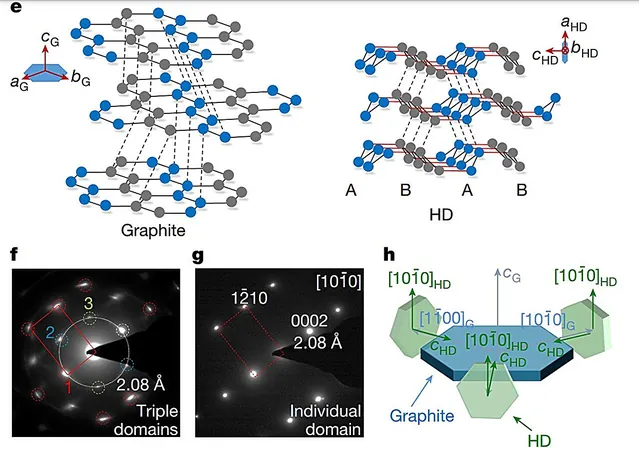
Unleashing the Power of Superdiamonds: Scientists Create Revolutionary Hexagonal Diamond
2025-08-04
Author: Mei
A Breakthrough in Diamond Technology
Diamonds have long dazzled us with their beauty, but they're also renowned as one of the hardest substances on Earth. Derived from the Greek word 'adámas,' meaning unbreakable, diamonds are the pinnacle of both allure and strength. Now, scientists have taken this concept to a new level by engineering a more resilient version known as bulk hexagonal diamond (HD)—a structure theorized for over 50 years to outperform traditional diamonds in terms of physical properties.
A Groundbreaking Study
In a groundbreaking study featured in the prestigious journal *Nature*, researchers from China achieved the synthesis of bulk hexagonal diamond, crafting crystals ranging from 100 micrometers to several millimeters. Utilizing an innovative method that involves compressing and heating high-quality graphite single crystals under carefully controlled pressure, they unveiled a meticulously ordered structure of HD.
The Future of Materials Engineering
This remarkable advancement not only showcases the potential of hexagonal diamond in technology but also opens up fresh avenues for exploration. Beyond their gleaming surface, diamonds are coveted for their remarkable chemical and physical properties that make them ideal for various applications, including cutting-edge biosensors, quantum computing, and heavy-duty industrial tools.
Understanding the Unique Structure of Diamonds
The incredible strength of diamonds comes from their unique cubic atomic structure, where each carbon atom is tightly bonded to four others in a rigid tetrahedral network. While this configuration explains the hardness of traditional diamonds, it also creates natural cleavage planes that limit their strength. Interestingly, research suggests that by strengthening and shortening the interlayer bonds, this conventional diamond could transform into a hexagonal structure—a change that holds great promise.
Nature’s Own Diamond: Lonsdaleite
Hexagonal diamond, or lonsdaleite, is not just a theoretical construct; it has been identified in nature, famously found in the Canyon Diablo meteorite. A previous study in 2022 proposed that the extreme temperatures and pressures from meteor impacts can convert graphite into this rare form of diamond.
Overcoming the Challenges of Synthesis
While scientists have attempted to replicate the conditions of these cosmic events in labs, previous attempts resulted in tiny, impure samples, making it difficult to assess the true properties of hexagonal diamond. This latest endeavor, however, successfully synthesized a highly ordered and nearly pure version under ambient conditions, marking a significant leap forward.
The Method Behind the Magic
Employing a diamond anvil cell (DAC) along with a large-volume multi-anvil press, the researchers created a controlled quasi-hydrostatic environment, ensuring uniform pressure was applied to minimize stress variations. Their bulk sample included densely packed crystals about 100 nanometers in size, primarily composed of hexagonal diamond with minor imperfections.
Documenting Exceptional Hardness
Spectroscopy analysis revealed a complete transformation of carbon bonds from sp2 to sp3, confirming a crystallographic shift from graphite to diamond. Further hardness tests indicated that the interlayer bonds in hexagonal diamond were not only stronger but also shorter than those of conventional diamonds, leading to slightly superior hardness metrics.
Toward Superior Diamond Quality
This pioneering study establishes the existence of hexagonal diamond as a legitimate phase of carbon, boasting hardness that rivals cubic diamonds. The researchers anticipate that refining graphite purification methods and further optimizing pressure and temperature conditions can yield even higher-quality hexagonal diamonds with enhanced properties.
With each development, we are one step closer to unlocking the full potential of this extraordinary material, potentially revolutionizing industries that rely on the exceptional qualities of diamonds.


 Brasil (PT)
Brasil (PT)
 Canada (EN)
Canada (EN)
 Chile (ES)
Chile (ES)
 Česko (CS)
Česko (CS)
 대한민국 (KO)
대한민국 (KO)
 España (ES)
España (ES)
 France (FR)
France (FR)
 Hong Kong (EN)
Hong Kong (EN)
 Italia (IT)
Italia (IT)
 日本 (JA)
日本 (JA)
 Magyarország (HU)
Magyarország (HU)
 Norge (NO)
Norge (NO)
 Polska (PL)
Polska (PL)
 Schweiz (DE)
Schweiz (DE)
 Singapore (EN)
Singapore (EN)
 Sverige (SV)
Sverige (SV)
 Suomi (FI)
Suomi (FI)
 Türkiye (TR)
Türkiye (TR)
 الإمارات العربية المتحدة (AR)
الإمارات العربية المتحدة (AR)